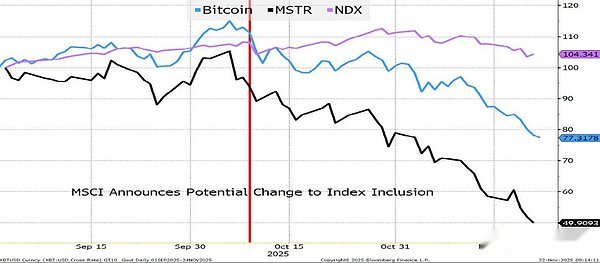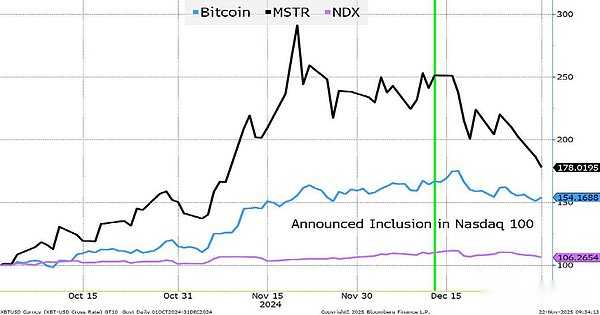
Author: Ye Zhen, Wall Street News
As this quote on social media puts it: “We are all long Bitcoin, some of us just don’t know it yet.”

On November 24, Peter Tchir, a well-known strategist at Academy Securities, warned in his latest report that as the era of “free money” comes to an end, this hidden leverage is coming back to bite the market.Over the past two years, the logic that companies could get their stock prices to rise multiple times simply by announcing huge spending plans has been shattered, a reversal that is at the heart of the Nasdaq’s recent decline.
The market has been volatile recently, with the Nasdaq 100 leading the way down more than 3%, while the more representative S&P 500 equal-weighted index fell only 0.9%.This divergence highlights that the pain is concentrated in technology and high-growth areas.
Especially on October 10, Bitcoin experienced a sharp sell-off from US$122,000 to US$105,000 during the closing period of the US stock market.This “inexplicable” collapse not only severely damaged crypto assets, but also put direct liquidity pressure on a wide range of stock investment portfolios through the transmission chain of ETFs and related listed companies.

This phenomenon reveals a dangerous signal in the current market structure: Cryptocurrency, artificial intelligence infrastructure construction and passive investment funds in US stocks have formed a highly correlated “tie chain connecting the river” trend.As the scale of passive investment exceeds that of active investment, through ETF tools such as QQQ, hundreds of millions of pension and safe-haven funds have actually been deeply tied to the capital expenditure cycles of “digital asset reserve companies” such as MicroStrategy and AI giants.
At present, investors’ eyes have collectively turned to the stability of the crypto market.Goldman Sachs trader Brian Garrett bluntly stated that many clients are viewing Bitcoin’s performance as a bellwether for future risk appetite. “If Bitcoin’s trend improves, the stock market rebound at the end of the year may get back on track.”
The collapse of the “free money” mechanism
In his report, Peter Tchir attributed the market boom over the past period to the “free money” effect.The so-called “free money” does not refer to the central bank’s liquidity injection, but refers to a specific phenomenon in corporate capital operations: when a company announces to spend X amount, but its market value increases by more than X, it essentially creates “free” shareholder wealth.This logic once existed mainly in two fields:
The first is AI and data center construction.Previously, tech giants could be enthusiastically rewarded by the stock market simply by committing to building more data centers (i.e., “build it and the customers will come” logic).Now, however, simply announcing increased spending has failed to translate into higher stock prices, and the market is beginning to question the return on these huge investments.Once stock prices no longer pay for it, companies’ next move is likely to be to cut back on spending, which would pose a threat to overall economic momentum.
This is followed by cryptocurrencies and “digital asset reserve companies” (DATs).Companies represented by MSTR once enjoyed huge valuation premiums. They used financing to purchase cryptocurrencies, thereby driving their stock prices to rise far beyond their holding costs.This positive cycle was once an important force supporting stock prices and underlying crypto assets.But now, this chain is becoming increasingly difficult to operate, and the trading prices of many DATs are gradually returning to not close to their net asset value (NAV), which means that the channel for “creating wealth out of thin air” is closing.
The “amplifier” effect of passive investing
The rise of passive investing adds to the complexity of the situation.Peter Tchir pointed out that when a large amount of money “blindly” poured into the Nasdaq 100 Index (QQQ),Fifty-five cents of every dollar goes to a handful of companies, including MSTR.
According to Bloomberg data, Vanguard, Blackrock and State Street, as passive investment giants, are the top five holders of MSTR. QQQ alone holds MSTR shares worth nearly US$1 billion.This position structure means that once major index compilation companies (such as MSCI) adjust their rules, it will trigger huge fund flows.

This kind of indexed investment makes the fluctuations of crypto assets no longer limited to the currency circle.The market is currently paying close attention to whether MSCI will include DATs in its stock indexes (the decision is expected to be announced on January 15).If MSCI decides to retain or include these companies, it will avoid forced selling and boost market expectations for the subsequent inclusion of such companies in the S&P 500 Index; otherwise, it may trigger mechanical selling by passive funds.
Soaring asset correlations and backlash from wealth effects
The market value of Bitcoin has recently fallen from a high of about US$2.5 trillion to US$1.85 trillion. Due to the evaporation of US$650 billion in wealth, the market’s “wealth effect” is encountering headwinds.
Peter Tchir observed that with the popularity of spot ETFs, investors are no longer able to isolate crypto assets from stock positions in their mental accounts.When investors see significant drawdowns in crypto ETFs in their integrated stock accounts, panic is more likely to spread throughout the portfolio, which is a very different state of mind than in the past when they needed to view assets in separate cold wallets.
Some well-known investors were even surprised to find that some of the non-crypto assets they held showed extremely high correlation with Bitcoin.This often means that the same investor group is facing liquidity pressure – when crypto assets plummet, they have to sell other liquid assets (such as U.S. technology stocks) to raise cash.This sell-off across asset classes has caused both Nasdaq volatility and the VIX to rise at the same time.
Macro fog and the Fed’s dilemma
At the macro level, the Fed’s policy path has once again become confusing.Market expectations for a December interest rate cut fluctuated sharply from 34% to 63% in just one day.Although employment data is mixed and inflation risks have not yet been fully resolved, the end of the “free money” era may lead to a slowdown in AI data center spending and thus a cooling of the economy, which provides the Federal Reserve with a reason to cut interest rates.
At the same time, the 10-year U.S. Treasury yield, a safe-haven asset, has rebounded recently, and the rise in Japanese bond yields (the 30-year Japanese bond yield hit 3.3%) also requires caution, which may weaken the attractiveness of U.S. bonds in the long term.
Peter Tchir concluded that the current economic risks are greater than ever before.If cryptocurrency cannot stabilize, the liquidity crunch and wealth shrinkage it triggers will not only end the carnival of technology stocks, but may also drag down the growth pace of the entire macro economy.
Everyone is waiting with bated breath: Bitcoin’s stop will be the first signal that the market confirms the end of the “painful trade.”
Brian Garrett, a trader at Goldman Sachs, said: “Many clients we have contacted believe that if Bitcoin trading conditions improve, the year-end rally may return again.”





